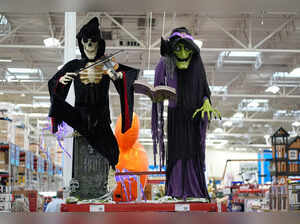World
Halloween Costs Spike as Tariffs Drive Up Prices for Decor and Costumes

Halloween is set to become more expensive this year, with rising prices for decorations and costumes largely attributed to tariffs imposed during the administration of former President Donald Trump. As October 31 approaches, consumers across the United States are feeling the impact of these increased costs, which have escalated prices for many Halloween essentials.
The holiday is cherished by many, with over two-thirds of Americans participating in festivities each year. However, as reported by Cheapism, approximately 90% of Halloween decorations are manufactured overseas, predominantly in China. The tariffs on these imports have made decorations significantly pricier for both retailers and consumers. Some items have seen price increases ranging from $20 to $200, depending on size and material.
As retailers grapple with these rising costs, many are forced to adjust their inventory and pricing strategies. While some companies may attempt to absorb a portion of the increased expenses, a substantial amount is passed onto shoppers. According to CNN, this shift in pricing could lead to fewer options available in stores, particularly for larger and more elaborate decorations.
Costume Prices on the Rise
Costumes are also experiencing price hikes, with many shoppers expected to pay an additional $5 to $10 per costume this Halloween. This increase brings the average estimated spending per person to around $115, marking an increase of $11 from last year, as indicated by a report from Newsweek. Some retailers even anticipate that specific costumes could see their prices double due to the heightened import fees on fabrics and accessories.
The growing popularity of themed family and group costumes further complicates budgeting for many households. The increased prices could lead consumers to either cut back on their decorating plans or spend more to create their desired festive atmosphere.
Fewer Options and Slightly Stable Candy Prices
Unfortunately for Halloween enthusiasts, the variety of decorations available this year may be limited. One major supplier revealed to CNN that it would not stock certain large animatronic decorations due to a price increase of $200, which is deemed excessive for most consumers. Other retailers are expected to reduce orders for large or complex decorations altogether, potentially steering shoppers toward do-it-yourself projects or smaller, more economical items.
On a brighter note, candy prices remain relatively stable. Most Halloween candy is produced in the United States, with price increases expected to be minimal, typically ranging from 2% to 5%. This is welcome news for trick-or-treaters and their families, as they can still indulge in traditional festive treats without significant financial strain.
Despite the rising costs associated with decorations and costumes, Halloween spending is projected to grow. The National Retail Federation estimates that shoppers will spend $4.2 billion this year, representing a $1.6 billion increase from six years ago. While tariffs and inflation contribute to this rise, changes in consumer habits also play a crucial role. Many individuals are investing more in home décor and elaborate displays, which has shifted the focus beyond just candy and costumes.
As Halloween evolves into a more comprehensive festive experience, it appears that the trend of increased spending will continue, even in the face of rising costs.
-

 World3 months ago
World3 months agoSBI Announces QIP Floor Price at ₹811.05 Per Share
-

 Lifestyle3 months ago
Lifestyle3 months agoCept Unveils ₹3.1 Crore Urban Mobility Plan for Sustainable Growth
-

 Science3 months ago
Science3 months agoNew Blood Group Discovered in South Indian Woman at Rotary Centre
-

 Sports3 months ago
Sports3 months agoBroad Advocates for Bowling Change Ahead of Final Test Against India
-

 World3 months ago
World3 months agoTorrential Rains Cause Flash Flooding in New York and New Jersey
-

 Top Stories3 months ago
Top Stories3 months agoKonkani Cultural Organisation to Host Pearl Jubilee in Abu Dhabi
-

 Science3 months ago
Science3 months agoNothing Headphone 1 Review: A Bold Contender in Audio Design
-

 Sports3 months ago
Sports3 months agoCristian Totti Retires at 19: Pressure of Fame Takes Toll
-

 Top Stories3 months ago
Top Stories3 months agoAir India Crash Investigation Highlights Boeing Fuel Switch Concerns
-

 Business3 months ago
Business3 months agoIndian Stock Market Rebounds: Sensex and Nifty Rise After Four-Day Decline
-

 Politics3 months ago
Politics3 months agoAbandoned Doberman Finds New Home After Journey to Prague
-

 Top Stories3 months ago
Top Stories3 months agoPatna Bank Manager Abhishek Varun Found Dead in Well









